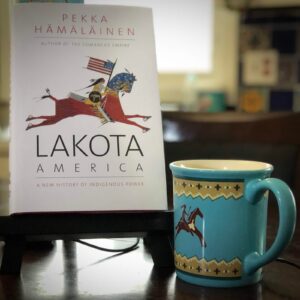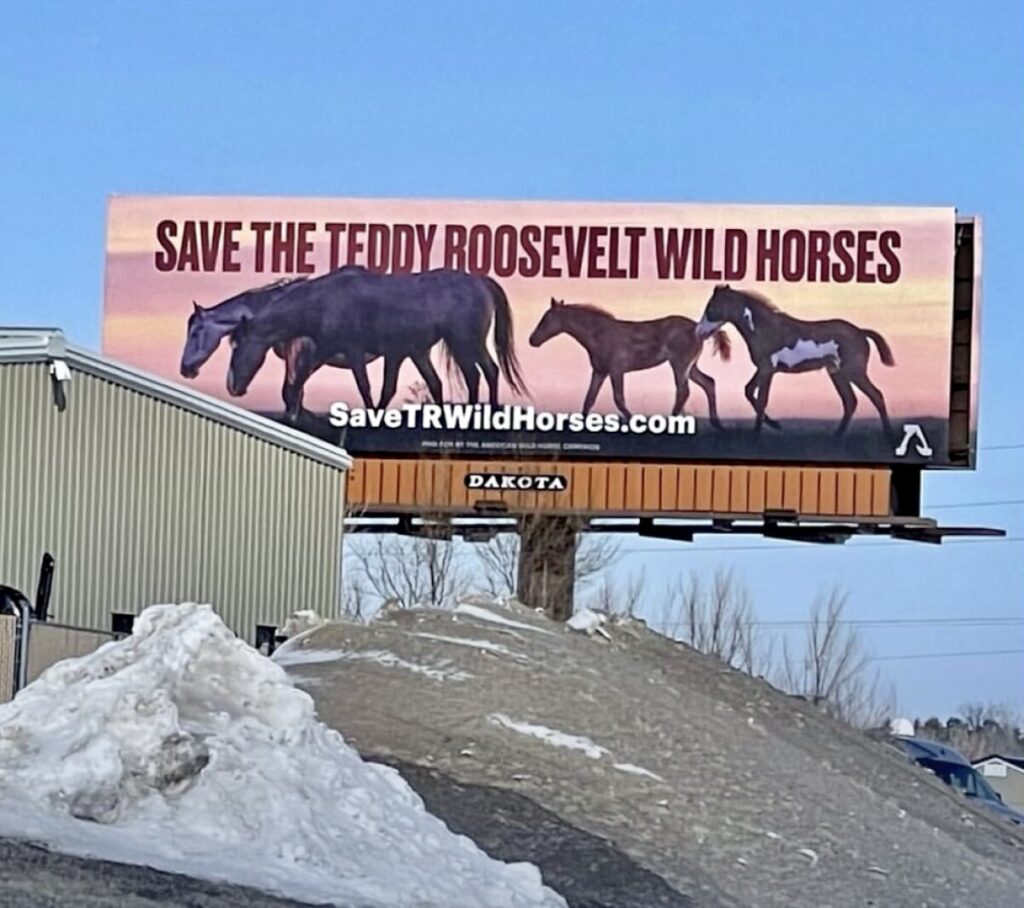Just how much of the romance of America is bound up in horses is unclear, but try to imagine the West without horses in it.

There’s horse trouble in Theodore Roosevelt National Park in western North Dakota. The park, created in 1947 to honor Roosevelt and protect the fragile Little Missouri River badlands, has a feral horse herd of about 200 head. In 2022, TRNP officials announced their tentative plan to thin or eliminate the horses. They have admitted that the horses are not damaging the park or competing with other fauna (buffalo, elk, deer, some pronghorn antelope, prairie dogs, coyotes) for scarce resources. However, park officials see the horses as livestock that are not native to the North Dakota badlands.
Fair enough. We all know horses did not exist in the Americas when Columbus bumped into the New World in 1492. Sometime later, Spanish conquistadors and missionaries brought them across the Atlantic Ocean in ships not much bigger than yachts. They escaped (or were liberated) from Spanish control in the Southwest in the 1680s. Some just drifted into the infinite, unfenced outback of America. Others were traded from tribe to tribe until they were more or less evenly distributed across the entire American West. Virtually every Native American tribe immediately recognized the revolutionary significance of the horse and transformed their cultures to accommodate the powerful, majestic, swift, and mystical creatures. The great Finnish historian Pekka Hämäläinen reminds us that Native American dogs had to be fed daily and could only haul small loads on a travois. The horse fed itself, and it was magnitudes stronger than a dog.
When we think of the “Indian Wars” of the American West, we envision Native American warriors dashing bareback across the plains without white civilization’s saddles, bits, or stirrups, leaning out under the horse’s neck and holding onto the horse’s backbone by the strength of their toes.

Just how much of the romance of America is bound up in horses is unclear, but try to imagine the West without horses in it. After he saves the day, does Shane walk off toward the far horizon? Imagine the Pony Express with no horses but just a staff of 5,000 fast-walkers hastening across Utah in a linear 2,000-mile relay race. Imagine Custer as an infantry commander. Imagine Crazy Horse as a pedestrian. Imagine a rodeo without horses.
Nobody is sure how horses wound up in Theodore Roosevelt National Park. One passionate group believes the horses are somehow related to Sitting Bull’s pony herd (almost certainly not true, park biologists and historians say). The horses are probably the descendants of strays left behind during the Dust Bowl years when ranchers and farmers gave up the struggle against the Great Plains and moved west to the temperate coasts in California, Oregon, and Washington. Park officials did not introduce the horses into TRNP. They were wild creatures minding their own business that found themselves fenced in when the park secured its perimeter boundaries.
The American people love the TRNP horses. When the park asked for public input, it received more than 20,000 comments, 99.9% of them in favor of keeping the horses in the park and leaving them alone. The American people do not see the feral horses as livestock. If they were livestock, there would be brands, vaccinations, castrations, roundups, feedlots, sales, and slaughterhouses. The public sees the horses as wildlife, just as entitled to find sanctuary in the national park as elk or bison. Much of the romance of the park is bound up with the horses — and the park’s great namesake, Theodore Roosevelt, was a passionate horseman, especially after the local hunters and cowboys told him he’d have to learn to saddle his favorite horse Manitou himself. The park would be diminished without the horses. If they were eating all the grass and shrubs and thus degrading the habitat or sending out angry nocturnal attack squads to kill all the deer and elk, we’d all understand their removal. But they are just quietly living their lives without any relationship with humans, except for a jurisdictional vulnerability of which they are entirely unaware.
The horse is always a semi-mystic creature. How humans managed to domesticate a creature of such bulk, strength, and fearfulness is unclear. They are not like goats or sheep or even cattle. A goat is not going to stomp you to death or throw you violently to the ground. When I read accounts of how the horse revolutionized plains Native culture — the Lakota, the Cheyenne, the Nez Perce, the Blackfoot, the Crow — I sometimes wonder how things started. What was step one? Let’s say five wild horses suddenly appeared in Blackfoot country (circa 1760). A gift from the Great Medicine — out of the blue and unprecedented. Flummoxed by their sudden appearance, the Blackfeet were unsure what to call them. They settled on “elkdogs.” Some wise elder said, imagine how valuable they might be if we can get on top of them and use them to haul loads, maximize the buffalo hunt, and run down our enemies? At that point, tribal leaders had to convince some swift and brave young men to go out and see if they could capture a couple of the huge and powerful creatures. How exactly? How does a pedestrian culture capture its first horse? You can see a trained modern horse breaker spend 45 minutes trying to get hold of a horse in a corral. Now try it on the open plains.
I Don’t Have a Dog in This Horse Fight
I don’t have a dog in this fight. I love the horses. My spirit is stirred whenever I see them grazing along the park’s hillsides. More than when I see the placid buffalo or the paranoid prairie dogs. Here are creatures that have never been roped, saddled, or ridden, living out their entire 25-year lives without ever being touched by a human being. They are entirely self-sufficient. They graze, wander, do all the herd dynamics of who’s in charge and who gets first access to the mares, and reproduce. Eventually, they die, and other nonhuman creatures come in to clean up the site. Some may starve in a bitter winter because nobody is hauling hay or oats to feed them. They live their whole lives outside of human agency. There is something magnificent about that and humbling to human self-importance. However, the feral horses are not outside human jurisdiction, and the park will almost certainly decide to reduce their numbers to about 30% of the current total. I can live with that. Most people can.
Generally speaking, I trust the National Park Service to do the right thing and make the right decisions. The NPS has a very carefully worked out set of procedures and protocols for big decisions of this sort. When it became necessary to reduce the number of elk in TRNP 15 years ago, the park’s superintendent, Valerie Naylor, handled the situation masterfully while being unfairly buffeted by a loud and largely uninformed public, in part because there was a detailed formal NPS process that made sure other options were seriously explored, made sure the public was genuinely involved and listened to, and that “no action” was one of the legitimate options for park officials to consider. Nothing happens precipitously in a National Park. No single rogue park ranger or superintendent can make unilateral decisions.

My guess is that most, but probably not all, of the feral horses will remain in Theodore Roosevelt National Park. Habitat management does not work by way of majority rule, however, not even a super-majority, as is the case with the horses in TRNP. But public sentiment does matter, and the public is adamant: keep the horses. No billboards on the side of the roads say to clear the horses out, but plenty urge us all to rally to their defense.
I wish the American public were as passionately committed to saving the white rhinoceros and the orangutan worldwide as they are to making a place in the national parks for feral horses. The white rhino and the orangutan are in danger of blinking out once and for all during our lifetime, while feral horses are doing just fine. It’s the romance of the American West that is endangered, not the sub-species in question.
The American people have lost faith in most institutions by which our lives are organized and restrained: Congress has a 12% approval rating, the Supreme Court 29%, the media 15%, and the criminal justice system 20%. The National Park Service should be largely immune from our national disillusionment because its 20,000 employees are among the most idealistic Americans, and they work tirelessly to preserve, protect, and promote the best of the public lands. We should be cautious about second-guessing them. I have never taken university courses in wildlife management or habitat integrity.
